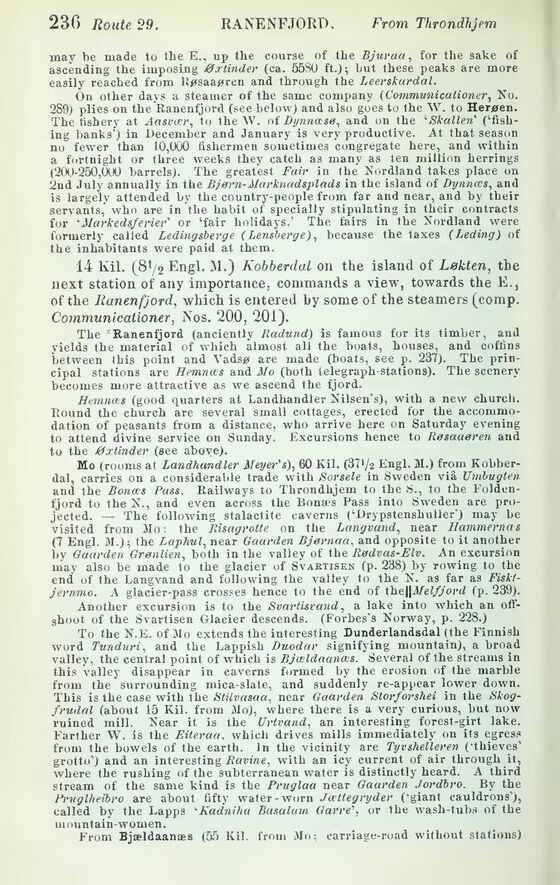
Full resolution (JPEG) - On this page / på denna sida - Norway - Pages ...

<< prev. page << föreg. sida << >> nästa sida >> next page >>
Below is the raw OCR text
from the above scanned image.
Do you see an error? Proofread the page now!
Här nedan syns maskintolkade texten från faksimilbilden ovan.
Ser du något fel? Korrekturläs sidan nu!
This page has never been proofread. / Denna sida har aldrig korrekturlästs.
may be made to the E., up the course of the Bjuraa, for the sake of
ascending the imposing Øxtinder (ca. 55S0 ft.); hut these peaks are more
easily reached from Køsaaøren and through the Leerskardal.
On other days a steamer of the same company (Communicationer, No.
289) plies on the Ranenfjord (see below) and also goes to the W. to Herøen.
The fishery at Aasvær, to the W. of Dynnæse’, and on the ’■Skallen’
(‘fishing banks’) in December and January is very productive. At that season
no fewer than 10,000 fishermen sometimes congregate here, and within
a fortnight or three weeks they catch as many as ten million herrings
(200-250,000 barrels). The greatest Fair in the Nordland takes place on
2nd July annually in the BJørn-Marknadsplads in the island of Dynnces, and
is largely attended by the country-people from far and near, and by their
servants, who are in the habit of specially stipulating in their contracts
for ‘Markedsferier’ or ‘fair holidays.’ The fairs in the Nordland were
formerly called Ledingsberge (Lensberge), because the taxes (Leding) of
the inhabitants were paid at them.
14 lvil. (8»/2 Engl. M.) Kobberdal on the island of Løkten, the
next station of any importance, commands a view, towards the E.,
of the Ranenfjord, which is entered by some of the steamers (comp.
Communicationer, Nos. 200, 201).
The sRanenfjord (anciently Radund) is famous for its timber, and
yields the material of which almost all the boats, houses, and coffins
between this point and Vadsø are made (boats, see p. 237). The
principal stations are Hemnæs and Mo (both telegraph-stations). The scenery
becomes more attractive as we ascend the fjord.
Hemnæs (good quarters at Landhandler Nilsen’s), with a new church.
Round the church are several small cottages, erected for the
accommodation of peasants from a distance, who arrive here on Saturday evening
to attend divine service on Sunday. Excursions hence to Røsaaøren and
to the Øxtinder (see above).
Mo (rooms at Landhandler Meyer’s), 60 Kil. (37’/s Engl. M.) from
Kobberdal, carries on a considerable trade with Sorsele in Sweden via Umbugten
and the Bonæs Pass. Railways to Throndhjem to the S., to the
Folden-fjord to theN., and even across the Bonæs Pass into Sweden are
projected. — The following stalactite caverns (‘Drypstenshuller") may be
visited from Mo: the Risagrotte on the Langvand, near Hammernas
(7 Engl. M.); the Laphul, near Gaarden Bjørnaa, and opposite to it another
by Gaarden Grønlien, both in the valley of the Rødvas-Elv. An excursion
may also be made to the glacier of Svabtisen (p. 238) by rowing to the
end of the Langvand and following the valley to the N. as far as
Fiskt-jernmo. A glacier-pass crosses hence to the end of the\\Melfjord (p. 239).
Another excursion is to the Svartisvand, a lake into which an
offshoot of the Svartisen Glacier descends. (Forbes’s Norway, p. 228.)
To theN.E. of Mo extends the interesting Dunderlandsdal (the Finnish
word Tunduri, and the Lappish Duodar signifying mountain), a broad
valley, the central point of which is Bjældaanæs. Several of the streams in
this valley disappear in caverns formed by the erosion of the marble
from the surrounding mica-slate, and suddenly re-appear lower down.
This is the case with the Stilvasaa, near Gaarden Storforshei in the
Skog-frudal (about 15 Kil. from Mo), where there is a very curious, but now
"ruined mill. Near it is the Urtvand, an interesting forest-girt lake.
Farther W. is the Eiteraa, which drives mills immediately on its egress
from the bowels of the earth. In the vicinity are Tyvshelleren (’thieves’
grotto’) and an interesting Ravine, with an icy current of air through it,
where the rushing of the subterranean water is distinctly heard. A third
stream of the same kind is the Pruglaa near Gaarden Jordbro. By the
Priiglheibro are about fifty water-worn Jwtlegryder (‘giant cauldrons’),
called by the Lapps ‘Kadniha Basalam Garre’, or Ihe wash-tubs of the
mountain-women. _
From Bjældaanæs (55 Kil. from Mo: carriage-road without stations)
<< prev. page << föreg. sida << >> nästa sida >> next page >>